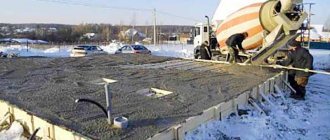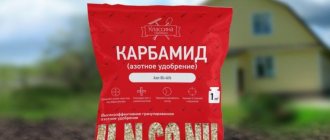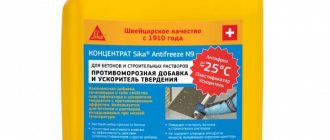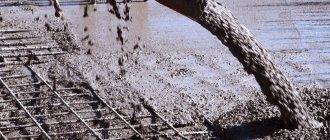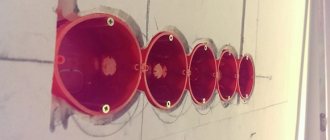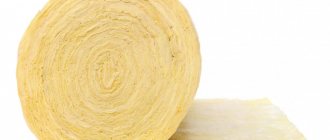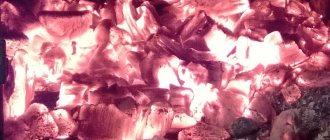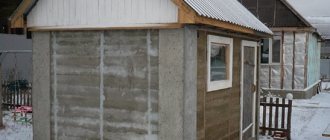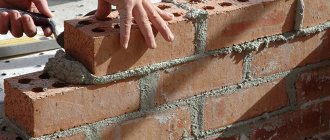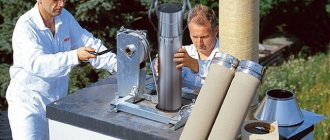Due to various circumstances, construction deadlines may change, for example, work that requires suitable weather may have to be rescheduled. First of all, this applies to pouring monolithic concrete structures. This material changes its setting speed depending on the ambient temperature. In a closed space, you can create the necessary microclimate so that the hardening process is uniform. For outdoor work, you need to know the optimal temperature for pouring concrete outdoors.
At what temperature can concrete be poured outdoors?
Concrete mortar is used to obtain a monolithic structure. Structural elements of the building should not have cracks, cavities or breaks as a result of hardening of the material.
Full strength is usually gained within 4 weeks. At this time, hydration of the cement in the concrete occurs. The first stage of this process is grasping. Cement granules react to contact with water and form crystals, which are subsequently bonded together. This process lasts the first 7-10 hours.
The second stage is concrete hardening (strength gain). The clinker component reacts with water, forming the silicate structure of the future monolith. Small crystals combine to form a porous surface.
Water is continuously involved in the hardening process, so it should not freeze or evaporate. That is, the normal process of gaining strength cannot take place in hot or cold weather.
The recommended temperature for working with concrete mortar is +20°C.
An acceptable temperature should be not only in the first 10 hours after pouring the solution, but also for 28 days until the monolith gains strength. The surface cannot be loaded during this period.
If the temperature regime is not observed, the waiting time increases. If you continue work without waiting for complete hardening, the monolith may become covered with cracks, fungus will form on the surface, and the entire structure will become unsuitable for use.
Are there minimum and maximum restrictions for carrying out work?
Sometimes circumstances are such that work must be carried out in hot summers or cold winters. There are temperature indicators that cannot be exceeded.
The minimum concrete hardening temperature at which the solution can be poured without adding additives and additional heating is +5°C.
The minimum temperature at which concrete is poured without additives is -3°C (in this case, the temperature of the solution must be maintained at +10°C for at least three days).
Various additives and methods of heating mortar or reinforcement make it possible to pour concrete at sub-zero temperatures.
Maximum temperature for working with concrete: +25°C. In hotter weather, work is carried out much faster, since the concrete sets in less time. The poured surface is additionally moistened every 2-3 hours.
General information
Depending on the temperature at which the cement hardens, the hardening period also differs. The best temperature is 20°C. Under ideal conditions, the process takes 28 days. In hot regions or during cold periods of the year, it is difficult or impossible to maintain this temperature.
In winter, concreting is required for a number of reasons:
- laying the foundation for a building located on crumbling soils. During the warm period of the year it is impossible to carry out construction;
- In winter, manufacturers make discounts on cement. Sometimes you can really save a lot on material, but storing it until it gets warmer is an undesirable solution, because the quality of the cement will decrease. Pouring concrete on the interior surfaces of buildings and even exterior work in winter is quite appropriate if discounts are available;
- private concreting work;
- In winter there is more free time and it is easier to take a vacation.
The disadvantage of working in cold weather is the difficulty of digging a trench and the need to equip a heating area for workers. Taking into account additional costs, savings do not always occur.
The influence of negative temperature on concrete hardening
At temperatures above +5°C, cement hydration occurs normally. If the temperature suddenly drops below 0°C, the water in the mixture will freeze and the process will freeze. In this case, the crystals that began to form in the warm mixture will remain in the solution. Winter concrete hardens much longer. If additives are not added to it and it is not heated, the monolith will be heterogeneous, with cracks.
If, after freezing, the solution is heated and the water is melted, then new bonds will form incorrectly and the monolith will not receive the necessary strength.
Brickwork installation - optimal temperature range
In order for the finished masonry to be of high quality, it is recommended to carry out work at an air humidity of no higher than 75%, and the temperature can vary in the range of 10 - 25 0 C.
Warm and dry weather improves the adhesion of the mortar to the brick, which has a positive effect on the quality of the finished masonry, and also contributes to the durability and strength of the finished structure. Of course, even if work is carried out exclusively in the warm season, the presented optimal combination of parameters will not always be observed. Deviations in both humidity and temperature are quite acceptable. If they make up no more than 10%, then this will not have a fundamental impact on the quality characteristics of the finished structure.
However, as the ambient temperature approaches zero, it is necessary to reconsider the approach to organizing masonry work.
How to pour concrete in winter at low temperatures
Sometimes construction work is carried out in winter. For example, when constructing a building on loose soils. Pouring concrete in winter is cheaper due to lower prices for work and materials. The disadvantage of working in cold weather is the long drying period. In addition to adding additives, there are methods of physically heating the mixture or structure.
Thermos method
Hardening of cement mortar is an exothermic reaction, as a result of which a large amount of heat is released. Thus, the poured solution heats itself. To increase the cooling time, the poured structure is covered with thermal insulation material. Even at temperatures well below 0°C, concrete has time to gain strength before it cools completely.
Initially, the solution temperature should not be lower than +10°C. When heated to 25-45°C, the result is much better.
To avoid destruction, at the beginning of the work a technological calculation is made, which takes into account the volume of the structure, the average daily temperature and heat loss.
Electric heating of concrete mixture
This method allows the mixture to be heated evenly, while its strength increases and its service life increases.
The method is based on the ability of cement to conduct electricity. The electrodes are mounted inside the solution and on the surface, and voltage is supplied from the transformer. The parameters depend on the brand of cement, air temperature, volume and shape of the structure.
Types of electrodes for heating:
- Stripes. Used to heat horizontal structures. They are metal strips up to 5 cm wide.
- Rod. Sections of reinforcement with a diameter of up to 12 mm are installed in rows. The distance between the rods is determined in practice.
- Strings. Used for vertical structures, they are reinforcement with a diameter of up to 15 mm and a length of up to 3 m.
The electrodes are placed in the poured solution according to the following scheme: no closer than 3 cm to the formwork, no closer than 10 cm to the technological seam, the distance between the electrode rods and the frame reinforcement rods is 5-15 cm, the minimum distance between the working elements is 20 cm.
A prerequisite for electric heating of the mixture is additional thermal insulation.
The electrodes are connected to a generator that supplies alternating current. Direct current cannot be used during heating, as it provokes electrolysis and water molecules are destroyed, and cement hydration does not occur.
It is not recommended to use a welding machine for heating, as it can quickly fail.
The electric heating method has a number of disadvantages:
- High costs for consumables (electrodes remain in the monolith).
- High energy costs (about 1000 kV per 3-5 m3 of solution).
- The need for additional calculations.
Steam heating of concrete in winter
The method is used at facilities where there is already a large volume of steam and insufficient electricity. The disadvantage of this method is large heat losses.
Steam is delivered to the solution through capillary formwork, as well as by launching steam into hothouses and steam jackets. The pressure and temperature of the steam depend on the grade of cement from which the concrete is made.
The jacket is the space between the formwork and the vapor-tight lining, through which heated, moist air circulates under pressure. The distance between the steam supply points is no more than 2 m. Jackets are used to heat vertical structures, as well as interfloor ceilings. Warming up in this way is uneven, with large heat losses.
A heater is a removable, portable structure that is used to heat the foundations and soles of a building. Steam is supplied to the heater through a hose.
Capillary formwork is the most effective method. Consists of wooden panels with grooves sewn up with metal strips. At the bottom of the shield there is a fitting through which steam is supplied. On the outside, the shields have additional insulation. This method has good heat treatment properties for the solution.
Floor screed
In order to create a fairly even floor surface, a cement-based mortar is used. This work is quite complex and requires increased attention. The floor screed is laid on a base made of a layer of crushed stone or gravel.
Cement calculation
For work such as floor screed, only two grades of cement are used: M-200 or M-150. For the floor, you can purchase an already prepared mixture that already contains plasticizers. But this option can cost much more. When using cement, grade M-150, take one part of cement and about three parts of sand. When using material with the M-200 grade, one part of cement and two parts of sand are most often taken.
Special antifreeze additives for the solution
To increase frost resistance, special chemical components are used. They make it possible to carry out work down to a temperature of -25°C.
Additives – increase hydration in frost conditions. They accelerate setting and hardening in combination with additional heating of concrete.
Antifreezes are compounds that increase the adhesion properties of a solution under any operating conditions. Additives are divided according to the main active ingredient included in the composition:
- Sodium formate. Increases the accumulation of salts in the monolith, used only in conjunction with plasticizers.
- Sodium chloride. Provokes corrosion of reinforcement and prevents rapid thickening of the solution. Suitable for Portland cement based mixtures.
- Sodium nitrite. Not used for alumina mixtures. Working with the solution becomes possible down to -15°C.
- Calcium carbonate (potash). Increases the operating temperature range to -30°.
Plasticizers - increase the density of the mixture, reducing the cost of cement and water. The working time for concrete with these additives is much longer, which allows you to take your time when laying.
Hardening accelerator - reduces working time, increases the strength of finished monoliths, but reduces the plasticity of concrete.
Complex additives - combine several ways to improve frost-resistant qualities.
The nuances of using additives:
- The operating conditions of the concrete structure are taken into account. For example, if the monolith will be exposed to intense gas, the concrete solution should not contain additives obtained from the reaction of calcium and hydrochloric acid.
- It is not recommended to mix additives on your own to improve various properties of the solution. The chemical elements included in the composition can negatively interact with each other. It is better to use ready-made complex additives.
- The presence of outlet and insert elements implies the use of antifreeze. It is added to the solution at the mixing stage.
Other methods of protection
If antifreeze additives are not used, and the air temperature drops lower and lower, you can protect the cement in other ways:
- Using warm water when mixing concrete. This is a method of quickly freezing masonry, which avoids disruption of the hydration process.
- Warming up the construction site using electric heaters. A very expensive method.
- Protection with slabs or shields wrapped in any heat-insulating material, for example, polyethylene film. You just need to remember that they can stick to the surface of the poured solution, so it’s worth considering the option of supports for thermal insulation.
Using the same slabs, you can try to warm up unhardened concrete that has already been damaged by frost.
Finishing work with cement, for example, plastering the surface, even if the order of sand, clay, gypsum and other materials has already been carried out, is best left until spring, when a stable above-zero temperature has established. Otherwise, no matter how careful the plasterers’ work, the finish will fall off the wall within a few days.
Artificially increasing the rate of hardening
The hardening time of cement mortar in cold weather increases greatly, but the time frame still remains limited. To speed up the procedure, various techniques have been developed.
BITUMAST Anti-frost additive for concrete
In modern construction, drying time can be accelerated by:
- adding additives;
- electric heating;
- increasing the required proportions of cement.
Using Modifiers
The easiest way to complete work on time even in winter is to use modifiers. When a certain proportion is added, the hydration period is reduced; when using some additives, hardening occurs even at -30°C.
Conventionally, additives that affect the rate of hardening are divided into several groups:
- type C – drying accelerators;
- type E – water-substituting additives with accelerated hardening.
The foundation hardening calculator and reviews show maximum effectiveness when potassium chloride is added to the solution. The material is consumed economically, since its mass fraction is up to 2%.
If you use type C concrete curing mixtures, you should take care of heating, since they do not protect against freezing.
Plasticizers and additives for concrete
It is recommended to take care of laying communications in the foundation or screed in advance, otherwise drilling holes will be required. Making communication holes after hardening will require a special tool and grinding of the concrete surface. The procedure is quite labor-intensive and reduces the strength of the structure.
Concrete heating
Mostly, a special cable is used to heat the composition, which converts electric current into heat. The technique provides the most natural way of hardening. An important factor is the need to follow the instructions for installing the wire. The method protects against liquid crystallization; there are also tools (hair dryer, welding machine) and thermal insulation to protect against freezing.
Increasing cement dosage
Increasing the cement concentration is used only with a slight decrease in temperature. It is important to increase the dosage in small quantities, otherwise the quality and durability will be significantly reduced.
Choosing the time of year
High-quality brickwork is performed only at positive temperatures and normal air humidity. The lower the reading on the thermometer, the worse the brickwork mortar hardens, and at minus values this process stops.
You can learn how to use single solid building brick m 150 from this article.
At low temperatures, the water contained in the cement composition can freeze and turn into ice. Therefore, there can be no talk of any interaction of chemical components.
What is the size of a single brick is indicated in this article.
If the reaction managed to occur before the frost and the solution holds the masonry, it may turn out that it did not harden, since it was prevented by the same water, which turned into ice. Because of its shape, it lost its usual plasticity, and the seams between the bricks were poorly sealed. After thawing and hardening of the cement composition, the strength characteristics of the brickwork are noticeably reduced.
